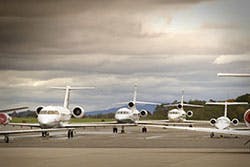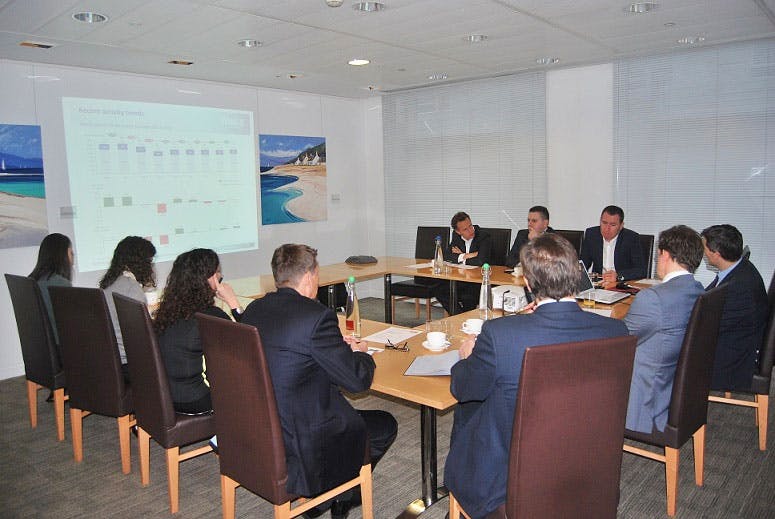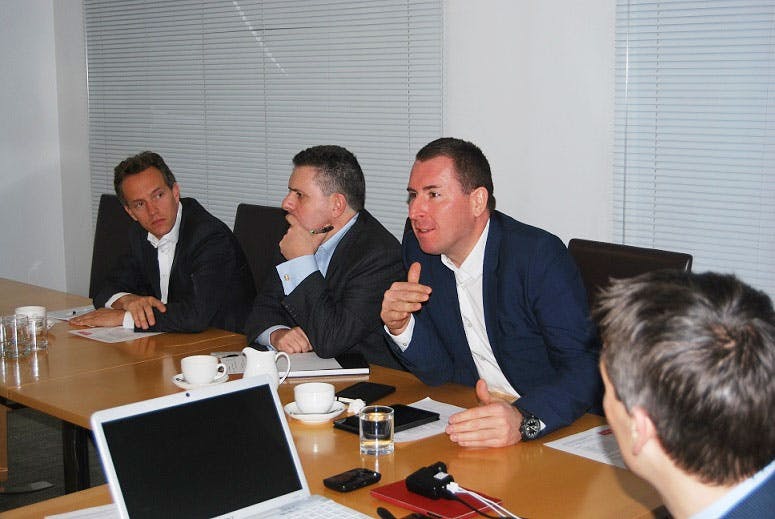Fleet size matters, says industry Round Table

Last week PrivateFly hosted an industry round table, looking at some of the commercial challenges for private jet operators in today’s market. Specifically on the agenda was the subject of fleet size and scale – the relationship between aircraft numbers and business success.
We were delighted to welcome several aircraft operators from our network: Patrick Margetson-Rushmore, CEO of London Executive Aviation (now part of Luxaviation Group); George Rolls, Non-Executive Director of Gama Aviation PLC (the new entity created by operator Hangar8’s reverse takeover of Gama); Bernhard Fragner, CEO of GlobeAir; and Cameron Ogden, Managing Director of Blink.

We were also pleased to host journalists from the Financial Times; Alasdair Whyte from industry title Corporate Jet Investor; and Richard Koe, Managing Director of intelligence provider WingX-Advance.
Our venue was accountancy firm Smith & Williamson, and head of M&A Brian Livingstone had some interesting insights to share, having considerable experience in working with companies in the aviation sector.
2014 – Big picture update
Richard Koe of WingX started off the session by giving us all a quick big picture update on business aviation flight movements in 2014, focussing on the two major global markets of North America and Europe.
As his figures showed, North America is bouncing back more showing signs of post-recession recovery, with year on year growth of 4.8% in 2014. Whereas Europe is still on a slight downward curve, with a 0.1% drop in year on year activity levels. The stats also backed up the ‘David & Goliath’ polarisation we have seen in aircraft choice for several years now in Europe: Growth in entry level jets and Ultra Long Range, but falling numbers in the middle. Whereas in North America, there is growth in most aircraft segments.
The key differences between Europe and the US
This prompted a reflection on the key market differences between the US and Europe. We agreed that the US offers a much bigger opportunity because of its geography and the lack of penetration of aircraft routes, compared to Europe. But some held the view that the US is a very different market in many ways and its more established nature makes it difficult for operators to enter.
We all agreed that the US business aviation user is more confident and aware of the benefits of private aviation – one example is the greater willingness to use turborprop aircraft, such as the KingAir, and to ask more detailed questions about their aircraft and crew.
In Europe there can be outdated perceptions about private aviation in the media – it is seen as a ‘champagne and caviar’ status symbol, rather than as a business tool. And a lack of understanding can influence customers’ aircraft choice, such as the tendency to disregard older aircraft, which can have an excellent maintenance and safety record and a fully-refurbished VIP interior.
However there was optimism in the room for Europe. Cameron Ogden, Managing Director of Blink said the opportunity for efficiency-led ‘point-to-point’ business travel is growing, as other options for business travel were not working – with airline congestion a growing problem. And the strict corporate travel policies of the last few years – where many European companies were excluding private aviation from their travel options altogether – are starting to lessen. The business case for private charter is starting to become clear again.

Growth challenges vary depending on business model
We moved on to talking about aircraft operators specifically and their business models. And began by clarifying the three different types:
1) Charter dedicated: The operator owns their aircraft outright and offers them for commercial charter.
2) Charter managed: The operator manages an aircraft and arranges charter on behalf of the aircraft’s private owner – when they are not using it.
3) Private managed: The operator manages aircraft for private owners who don’t offer their aircraft for commercial charter.
We discussed the differences in these types of businesses and the operational challenges for each. It was generally agreed that charter dedicated companies work on the basis of a ‘higher risk, higher reward’ model, whereas the others have a ‘lower risk, lower reward’. Bernhard Fragner of GlobeAir (a charter dedicated operator) commented that others were already offering a charter managed service well when he started the business and, having tried it before, he found the complexities of scheduling around the owner’s private flight time a commercial barrier: “We wanted to move aircraft where and when we liked”.
How does fleet size impact business profitability?
For those operators who buy their own aircraft, the costs are higher. We looked at figures which indicated that a pure charter managed operation needed 10 or more aircraft to break even, whereas the other business models could become profitable with 4 or 5. Bernhard Fragner of GlobeAir agreed with this summary and discussed the pressure to maintain business levels in the European low season (Nov – Feb) when your business is dependent on charter revenue. The asset value for pure charter aircraft was also different, with depreciation a bigger factor, due to the aircrafts’ greater utilisation compared to those belonging to private owners.
On average, across all business models, the figures indicate that operators with more than 7 aircraft in their fleet are more commercially viable in today’s challenging business environment.
Consolidation is increasing – but Europe is still a highly fragmented market
Europe still has a very fragmented market when it comes to private aircraft operators. There are over 1600 operators holding an AOC (Aircraft Operator’s Certificate), but 95% of them offer a fleet size of less than 10 aircraft – with almost half offering just one. The average operator offers 2 or 3 aircraft. This is why from a customer perspective, it has been difficult to compare the market. Technology such as PrivateFly is now making it easier, by linking the customer to available charter aircraft through an online marketplace.
Consolidation is now accelerating, with larger operators acquiring others – and we discussed some of the key acquisitions of the last two years, including those by Luxaviation and Gama. But these larger companies still account for less than 5% of Europe’s total aircraft fleet.
We also touched on other ways of consolidating without joining legal entities – mirroring the route sharing and alliances developed in the airline industry. The group agreed that this could have some benefits in terms of buying power, but several people around the table felt the complexities of such an arrangement made it practically an unlikely route to success.
How does consolidation work best?
With the business case made for scaling up, the group also discussed some of the benefits and challenges of integrating two businesses. We talked about how you make the important business decision of who to join forces with. Identifying key synergies such as geographical fit is essential, but also in terms of vision and culture.
The benefits can be significant in the form of better buying power for fuel, landing fees, insurance and crew, as well as client retention – being able to offer a broader range of aircraft and geographical reach. We also discussed how empty legs can be better utilised in a larger business or group.
It was also agreed that service speed with suppliers – such as fuel – was just as important as cost. In private aviation, you cannot afford to wait two hours for a refuel. So you would pay more for a dedicated fuel service for business aviation aircraft.
A number of challenges were identified, including the difficulties of combining different brands. Patrick Margetson-Rushmore commented that private aviation was very much a people business and that brand was an important signifier of that. So Luxaviation have taken the decision to keep their brands separate, while merging operations behind the scenes.
What is the impact on the customer?
Whether a full rebrand or at an operational level, all agreed that while standardisation is necessary when companies merge and grow, it’s important to remember the key differentiators of private aviation. Personalised service and flexibility to the customer should remain absolutely central.
Today’s private jet customer wants the commercial benefits of scale but without any loss to service levels – this is one of the key business challenges in the current market and going forward.
We discussed the importance of driving costs down while becoming ever more fast and responsive to customers. And how technology such as PrivateFly is playing a key role in this, making it faster and easier for operators to reach customers and provide quotes. The role of the intermediary such as PrivateFly, was agreed to be as essential element in what is still such a fragmented and complex market.
PrivateFly works with an accredited network of over 2,500 global private jet operators, offering a combined fleet of over 7,000 aircraft. To compare the best options for your flight itinerary, contact us or speak to our Flight Team (24 hours) on +44 1747 642 777.
.

Related content



